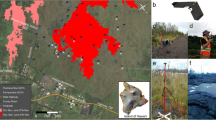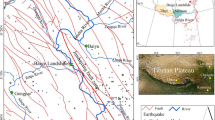Abstract
Climate warming increases thermokarst landscapes and thus leads to land degradation in the Circum-Arctic regions. Thermokarst landscapes were estimated to cover ~ 20% of the northern permafrost region, and their development is related to ground ice content and topographic conditions. However, changes in thaw slump distribution and development in mid- to low-latitude permafrost areas largely remain unknown. Here, we selected the Qilian Mountains of the northern Qinghai-Tibetan Plateau (QTP) as the study area. Combined with field investigation to measure the boundary of thaw slump using Real Time Kinematic (RTK), we analyzed historical changes in thaw slumps using 1969 and 1997 aerial photographs, 2009 and 2015 satellite imagery, and 2017 unmanned aerial vehicle (UAV) aerial images. The results showed that there are 15 thaw slumps covering an area of 0.03 km2, which were mainly distributed in terrain with a slope of 2–8° and elevation of 3552–3611 m. For the time periods of 1997–2009, 2009–2015, and 2015–2017, the average increase rates of thaw slump areas were approximately 61.8, 60.0, and 156.8 m2/y, and annual headwall retreat rates were approximately 1.3, 1.6 and 2.0 m/y. Based on the slopes, aspects, and altitudes from the Digital Elevation Model generated by UAV imagery, it suggested that geomorphic factors have no significant effect on the growth rates of thaw slump due to high heterogeneities of alpine environments. Our results showed that thaw slumps with polycyclic and active characteristics covered at least 0.9% of northern QTP permafrost regions and are expected to rapidly accelerate with climate warming.











Similar content being viewed by others
References
Abbott BW, Jones JB (2016) Permafrost collapse alters soil carbon stocks, respiration, CH4 , and N2O in upland tundra. Glob Chang Biol 21:4570–4587
Abbott BW, Larouche JR, Jones JB, Bowden WB, Balser AW (2014) Elevated dissolved organic carbon biodegradability from thawing and collapsing permafrost. Journal of Geophysical Research-Biogeosciences 119:2049–2063. https://doi.org/10.1002/2014jg002678
Brooker A, Fraser RH, Olthof I, Kokelj SV, Lacelle D (2015) Mapping the activity and evolution of retrogressive thaw slumps by tasselled cap trend analysis of a Landsat satellite image stack. Permafr Periglac Process 25:243–256
Cao B, Gruber S, Zhang TJ, Li LL, Peng XQ, Wang K, Zheng L, Shao WW, Guo H (2017) Spatial variability of active layer thickness detected by ground-penetrating radar in the Qilian Mountains, Western China. J Geophys Res-Earth Surf 122:574–591. https://doi.org/10.1002/2016jf004018
Cao B, Zhang TJ, Peng XQ, Mu CC, Wang QF, Zheng L, Wang K, Zhong XY (2018) Thermal characteristics and recent changes of permafrost in the upper reaches of the Heihe River basin, Western China. J Geophys Res-Atmos 123:7935–7949. https://doi.org/10.1029/2018jd028442
Cao B, Zhang TJ, Wu QB, Sheng Y, Zhao L, Zou DF (2019) Permafrost zonation index map and statistics over the Qinghai-Tibet plateau based on field evidence. Permafr Periglac Process 30:178–194. https://doi.org/10.1002/ppp.2006
Cassidy AE, Christen A, Henry GHR (2017) Impacts of active retrogressive thaw slumps on vegetation, soil, and net ecosystem exchange of carbon dioxide in the Canadian High Arctic. Arctic Science 3:179–202. https://doi.org/10.1139/as-2016-0034
Chen J, Liu L, Zhang T, Cao B, Lin H (2018) Using persistent scatterer interferometry to map and quantify permafrost thaw subsidence: a case study of Eboling Mountain on the Qinghai-Tibet plateau. J Geophys Res 123:2663–2676
Cheng G, Jin H (2012) Permafrost and groundwater on the Qinghai-Tibet plateau and in Northeast China. Hydrogeol J 21:5–23. https://doi.org/10.1007/s10040-012-0927-2
Chin KS, Lento J, Culp JM, Lacelle D, Kokelj SV (2016) Permafrost thaw and intense thermokarst activity decreases abundance of stream benthic macroinvertebrates. Glob Chang Biol 22:2715–2728. https://doi.org/10.1111/gcb.13225
Fuchs M, Grosse G, Strauss J, Gunther F, Grigoriev M, Maximov GM, Hugelius G (2018) Carbon and nitrogen pools in thermokarst-affected permafrost landscapes in Arctic Siberia. Biogeosciences 15:953–971. https://doi.org/10.5194/bg-15-953-2018
Hu B, Wu Y, Zhang X, Yang B, Chen J, Li H, Chen X, Chen Z (2019) Monitoring the thaw slump-derived Thermokarst in the Qinghai-Tibet plateau using satellite SAR interferometry. J Sensors 2019:1–8
Jensen AE, Lohse KA, Crosby BT, Mora CI (2014) Variations in soil carbon dioxide efflux across a thaw slump chronosequence in northwestern Alaska. Environ Res Lett 9:025001. https://doi.org/10.1088/1748-9326/9/2/025001
Ji-Chun WU, Sheng Y, Hui YU, Jin-Ping LI (2007) Permafrost in the middle-east section of Qilian Mountains(II):characters of permafrost. J Glaciol Geocryol 29:426–432
Jones MKW, Pollard WH, Jones BM (2019) Rapid initialization of retrogressive thaw slumps in the Canadian High Arctic and their response to climate and terrain factors. Environ Res Lett 14:055006
Jorgenson MT, Osterkamp TE (2005) Response of boreal ecosystems to varying modes of permafrost degradation. Can J For Res 35:2100–2111. https://doi.org/10.1139/X05-153
Katamura F, Fukuda M, Bosikov NP, Desyatkin RV, Nakamura T, Moriizumi J (2006) Thermokarst formation and vegetation dynamics inferred from a palynological study in Central Yakutia, eastern Siberia, Russia. Arct Antarct Alp Res 38:561–570. https://doi.org/10.1657/1523-0430(2006)38[561:Tfavdi]2.0.Co;2
Kokelj SV, Burn CR (2005) Geochemistry of the active layer and near-surface permafrost, Mackenzie delta region, Northwest Territories, Canada. Can J Earth Sci 42:37–48. https://doi.org/10.1139/E04-089
Kokelj SV, Jorgenson MT (2013) Advances in thermokarst research. Permafr Periglac Process 24:108–119. https://doi.org/10.1002/ppp.1779
Kokelj SV, Lantz TC, Kanigan J, Smith SL, Coutts R (2010) Origin and polycyclic behaviour of tundra thaw slumps, Mackenzie Delta region, Northwest Territories, Canada. Permafr Periglac Process 20:173–184
Kokelj SV, Tunnicliffe J, Lacelle D, Lantz TC, Chin KS, Fraser R (2015) Increased precipitation drives mega slump development and destabilization of ice-rich permafrost terrain, northwestern Canada. Glob Planet Chang 129:56–68
Kokelj SV, Lantz TC, Tunnicliffe J, Segal R, Lacelle D (2017) Climate-driven thaw of permafrost preserved glacial landscapes, northwestern Canada. Geology 45:371–374. https://doi.org/10.1130/G38626.1
Lacelle D, Bjornson J, Lauriol B (2010) Climatic and geomorphic factors affecting contemporary (1950-2004) activity of retrogressive thaw slumps on the Aklavik plateau, Richardson Mountains, NWT, Canada. Permafr Periglac Process 21:1–15. https://doi.org/10.1002/ppp.666
Lacelle D, Brooker A, Fraser RH, Kokelj SV (2015) Distribution and growth of thaw slumps in the Richardson Mountains-Peel plateau region, northwestern Canada. Geomorphology 235:40–51. https://doi.org/10.1016/j.geomorph.2015.01.024
Lakeman TR, England JH (2012) Paleoglaciological insights from the age and morphology of the Jesse moraine belt, western Canadian Arctic. Quat Sci Rev 47:82–100. https://doi.org/10.1016/j.quascirev.2012.04.018
Lantuit H, Pollard WH (2008) Fifty years of coastal erosion and retrogressive thaw slump activity on Herschel Island, southern Beaufort Sea, Yukon territory, Canada. Geomorphology 95:84–102. https://doi.org/10.1016/j.geomorph.2006.07.040
Lantz TC, Turner KW (2015) Changes in lake area in response to thermokarst processes and climate in old crow flats, Yukon. J Geophys Res-Biogeosci 120:513–524. https://doi.org/10.1002/2014jg002744
Lewkowicz AG, Way RG (2019) Extremes of summer climate trigger thousands of thermokarst landslides in a high Arctic environment. Nat Commun 10:1329. https://doi.org/10.1038/s41467-019-09314-7
Luo J, Niu F, Lin Z, Liu M, Yin G (2019) Recent acceleration of thaw slumping in permafrost terrain of Qinghai-Tibet plateau: an example from the Beiluhe region. Geomorphology 341:79–85
Mu CC, Zhang TJ, Wu QB, Cao B, Zhang XK, Peng XQ, Wan XD, Zheng L, Wang QF, Cheng GD (2015) Carbon and nitrogen properties of permafrost over the Eboling Mountain in the upper reach of Heihe River basin, northwestern China. Arct Antarct Alp Res 47:203–211. https://doi.org/10.1657/Aaar00c-13-095
Mu CC, Zhang TJ, Zhang XK, Li LL, Guo H, Zhao Q, Cao L, Wu QB, Cheng GD (2016) Carbon loss and chemical changes from permafrost collapse in the northern Tibetan plateau. J Geophys Res-Biogeosci 121:1781–1791. https://doi.org/10.1002/2015jg003235
Mu CC, Abbott BW, Zhao Q, Su H, Wang SF, Wu QB, Zhang TJ, Wu XD (2017) Permafrost collapse shifts alpine tundra to a carbon source but reduces N2O and CH4 release on the northern Qinghai-Tibetan plateau. Geophys Res Lett 44:8945–8952. https://doi.org/10.1002/2017gl074338
Niu FJ, Luo J, Lin ZJ, Liu MH, Yin GA (2014) Thaw-induced slope failures and susceptibility mapping in permafrost regions of the Qinghai-Tibet engineering corridor, China. Nat Hazards 74:1667–1682. https://doi.org/10.1007/s11069-014-1267-4
Niu F, Luo J, Lin Z, Fang J, Liu M (2015) Thaw-induced slope failures and stability analyses in permafrost regions of the Qinghai-Tibet plateau, China. Landslides 13:55–65
Olefeldt D, Goswami S, Grosse G, Hayes D, Hugelius G, Kuhry P, McGuire AD, Romanovsky VE, Sannel AB, Schuur EA, Turetsky MR (2016) Circumpolar distribution and carbon storage of thermokarst landscapes. Nat Commun 7:13043. https://doi.org/10.1038/ncomms13043
Pizano C, Baron AF, Schuur EAG, Crummer KG, Mack MC (2014) Effects of thermo-erosional disturbance on surface soil carbon and nitrogen dynamics in upland arctic tundra. Environ Res Lett 9:075006. https://doi.org/10.1088/1748-9326/9/7/075006
Schuur EA, McGuire AD, Schadel C, Grosse G, Harden JW, Hayes DJ, Hugelius G, Koven CD, Kuhry P, Lawrence DM, Natali SM, Olefeldt D, Romanovsky VE, Schaefer K, Turetsky MR, Treat CC, Vonk JE (2015) Climate change and the permafrost carbon feedback. Nature 520:171–179. https://doi.org/10.1038/nature14338
Segal RA, Lantz TC, Kokelj SV (2016) Acceleration of thaw slump activity in glaciated landscapes of the Western Canadian Arctic. Environ Res Lett 11:034025. https://doi.org/10.1088/1748-9326/11/3/034025
Séjourné A, Costard F, Fedorov A, Gargani J, Skorve J, Massé M, Mège D (2015) Evolution of the banks of thermokarst lakes in Central Yakutia (Central Siberia) due to retrogressive thaw slump activity controlled by insolation. Geomorphology 241:31–40
Sun Z, Wang YB, Sun Y, Niu FJ, GuoyuLi, Gao ZY (2017) Creep characteristics and process analyses of a thaw slump in the permafrost region of the Qinghai-Tibet plateau, China. Geomorphology 293:1–10. https://doi.org/10.1016/j.geomorph.2017.04.045
Turetsky MR, Abbott BW, Jones MC, Anthony KW, Olefeldt D, Schuur EA, Koven C, McGuire AD, Grosse G, Kuhry P (2019) Permafrost collapse is accelerating carbon release. Nature 569:32–34
Wang QF, Zhang TJ, Ji-Chun WU, Peng XQ, Zhong XY, Cui-Cui MU, Wang K, Qing-Bai WU, Cheng GD (2013) Investigation on permafrost distribution over the upper reaches of the Heihe River in the Qilian Mountains. J Glaciol Geocryol 35:19–29
Wang BL, Paudel B, Li HQ (2016) Behaviour of retrogressive thaw slumps in northern Canada-three-year monitoring results from 18 sites. Landslides 13:1–8. https://doi.org/10.1007/s10346-014-0549-y
Wang QF, Jin HJ, Zhang TJ, Cao B, Peng XQ, Wang K, Xiao XX, Guo H, Mu CC, Li LL (2017) Hydro-thermal processes and thermal offsets of peat soils in the active layer in an alpine permafrost region, NE Qinghai-Tibet plateau. Glob Planet Chang 156:1–12. https://doi.org/10.1016/j.gloplacha.2017.07.011
Wang YB, Sun Z, Sun Y (2018) Effects of a thaw slump on active layer in permafrost regions with the comparison of effects of thermokarst lakes on the Qinghai-Tibet plateau, China. Geoderma 314:47–57. https://doi.org/10.1016/j.geoderma.2017.10.046
Wu QB, Zhang ZQ, Gao SR, Ma W (2016) Thermal impacts of engineering activities and vegetation layer on permafrost in different alpine ecosystems of the Qinghai-Tibet plateau, China. Cryosphere 10:1695–1706. https://doi.org/10.5194/tc-10-1695-2016
Wu XD, Zhao L, Liu GM, Xu HY, Zhang XL, Ding YJ (2018) Effects of permafrost thaw-subsidence on soil bacterial communities in the southern Qinghai-Tibetan plateau. Appl Soil Ecol 128:81–88. https://doi.org/10.1016/j.apsoil.2018.04.007
Zhang T (2012a) Progress of global permafrost and climate change studies. Quat Sci 32:27–38
Zhang ZQ (2012b) Thermal hazards prediction on Qinghai-Tibet plateau permafrost region. J Jilin Univ 42:454–461+484
Zhang T, Barry RG, Knowles K, Heginbottom JA, Brown J (2008) Statistics and characteristics of permafrost and ground-ice distribution in the northern hemisphere. Polar Geogr 31:47–68. https://doi.org/10.1080/10889370802175895
Zhao L, Jin H, Wang S (2005) Characteristics of ground ice distribution in permafrost regions along Qinghai-Tibet highway. China, Agu Fall Meeting
Funding
This work was supported by the Strategic Priority Research Program of Chinese Academy of Sciences (Grant No. XDA20100313, XDA20100103), the National Natural Science Foundation of China (Grant No. 41871050; 41801028), and Open Foundations of the State Key Laboratory of Frozen Soil Engineering (Grant No. SKLFSE201705).
Author information
Authors and Affiliations
Corresponding authors
Electronic supplementary material
ESM 1
(XLSX 14 kb)
Rights and permissions
About this article
Cite this article
Mu, C., Shang, J., Zhang, T. et al. Acceleration of thaw slump during 1997–2017 in the Qilian Mountains of the northern Qinghai-Tibetan plateau. Landslides 17, 1051–1062 (2020). https://doi.org/10.1007/s10346-020-01344-3
Received:
Revised:
Accepted:
Published:
Issue Date:
DOI: https://doi.org/10.1007/s10346-020-01344-3




